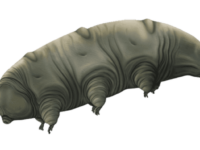A solitary dung beetle rolls its round cargo across the South African grassland, looking for a suitable place to bury its prize. It quickly distances itself from other beetles at the dung pile and avoids circling back to its original location, all while moving a ball of dung much larger than itself. However, in a landscape lacking navigational landmarks, the beetle knows exactly what direction to go. The moon is its guide. Specifically, it can see directions by detecting polarized light.
While humans can only witness polarized light through sunglasses or fancy photography lenses, for many organisms, this form of vision is the norm. Fish, birds, many invertebrates (insects, spiders, and crustaceans), and some mammals all use polarized light to guide navigation. Light from the sun is initially unpolarized, and the beams are made of waves moving in many directions along a linear path. If the light is scattered off gas molecules in Earth’s atmosphere — a phenomenon known as Rayleigh scattering — it becomes polarized, meaning the light now vibrates in a single plane. Even when direct sunlight is not visible, such as on cloudy days, under water, or even at night, polarized light cues can still be detected. While scientists have no way of knowing what polarized light looks like from an animal’s eyes, they guess it appears as wide bands stretching across the sky. The patterns are clearest in a 90-degree angle from the position of the sun or moon at rise or set.
While scientists have no way of knowing what polarized light looks like from an animal’s eyes, they guess it appears as wide bands stretching across the sky.
There is still much information to discover about light polarization and how it can be used for navigation. A study in Nature Communications discovered the greater mouse-eared bat as the first known mammal to use polarization patterns to navigate. Bats will travel hundreds of miles in a single night looking for food, but their echolocation — the locating of objects through reflected sound waves — only reaches up to a few dozen meters. In the study, scientists showed groups of bats different polarization signals with 90 degrees of difference at sunset. They then released the bats at 1 a.m. — when no polarization is visible — and tracked the bats with small radio transmitters. The bats which had been shown a shifted version of polarization signals set off in a direction roughly 90 degrees from their counterparts. Scientists hypothesize that these bats “calibrate” an internal compass against polarization signals each sunset. This method is advantageous over other navigational cues, like referencing the direction of the sunset, because it can be detected even if the sun is obscured by clouds. It is also the perfect solution to bats’ navigational challenges because polarization is very prominent at dusk and dawn, right when bats are venturing from and to their caves.
Scientists hypothesize that these bats “calibrate” an internal compass against polarization signals each sunset.
Another nocturnal creature, the dung beetle, uses polarized light from the moon to navigate. While these signals are weaker than those from the sun, they can be detected all night long, depending on the lunar phase. When the moon is full, it emits about the same amount of polarized light as the sun does during the day. However, as the lunar cycle wanes and the sky gets darker, the amount of light wanes too. In a 2019 study, researchers evaluated how the dung beetle Escarabaeus satyrus was affected by the strength of polarized light caused by the cycles of the moon. Scientists placed beetles and dung balls in a circle under a polarized light source and manipulated the amount of light given. They watched the beetles roll the balls to the edge of a circle, noted the angle, and repeated the experiment with different angles of light and strengths of polarization. They concluded that the beetles relied heavily on the direction of polarization and were able to detect signals equivalent to those emitted by a thin crescent moon. Due to their sensitivity at low signaling levels, scientists wonder whether light pollution from cities would hinder beetle navigation techniques.
While polarized light is not easily observed by humans, it is widespread in nature. Polarization vision is “so poorly understood,” according to a 2011 review in Current Biology, that there is still much to uncover about the mechanisms of polarization detection, sensitivities, and ability to be applied to navigational and light-sensing machinery.
J Exp Biol (2019). DOI: 10.1242/jeb.188532
Nature Communications (2014). DOI: 10.1038/ncomms5488
Current Biology (2011). DOI: 10.1016/j.cub.2010.12.012






